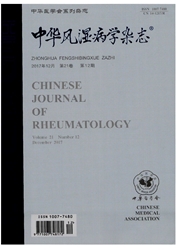

 中文摘要:
中文摘要:
目的 分析AOSD合并噬血细胞性淋巴组织细胞增多症(HLH)患者的临床特点.方法 回顾分析白2012年8月至2014年9月在北京协和医院住院的AOSD合并HLH患者的临床资料,并以同期住院的未合并HLH的AOSD患者作为对照组,采用t检验或Mann-whitney检验,x2检验(或Fisher精确概率法检验)进行数据分析,同时分析了AOSD合并HLH患者的治疗和预后.结果 AOSD合并HLH患者12例,占同期AOSD患者(96例)的13%.12例患者均为女性,发生HLH的年龄为19.7~52.3岁,平均(33±12)岁,从AOSD起病进展为HLH的病程为1~48个月,平均(20±24)个月.HLH可能诱因:AOSD活动9例,病毒感染3例.与对照组相比,AOSD合并HLH患者更容易出现弥漫性血管内凝血(3/12和1/84,P=0.006)和休克(2/12和0/84,P=0.014),血细胞减少[中性粒细胞3.14(0~21.98)×109/L和12.46(1.28~57.42)×109/L,Z=-4.309,P<0.01;血红蛋白(81±27)g/L和(107 ±21) g/L,t=3.815,P<0.01;血小板计数48(8~199)×109/L和316(81~1 016)×109/L,Z=-5.351,P<0.01],血ALT、AST、LDH明显升高[ALT 338(18~5 290) U/L和56 (9~3 227) U/L,Z=-3.097,P=0.002;AST 352 (35~15 964) U/L和50 (10~4 147) U/L,Z=-4.083,P=0.000;LDH 2 074(381~18 815) U/L和518(91~2 131) U/L,Z=-3.855,P=0.000],血清铁蛋白明显升高[16 990(6 321~59 952) U/L和2 092(118~44 169) U/L,t=-4.708, P=0.000],血纤维蛋白原明显降低[(1.3±0.6)g/L和(5.0±2.1)g/L,t=12.987,P<0.01].12例患者在诊断HLH后均接受大剂量糖皮质激素治疗,10例同时使用免疫抑制剂,2例使用人免疫球蛋白,感染患者同时予抗感染及支持治疗,1例死亡,11例存活患者随访2~20个月均病情平稳.结论 HLH常在AOSD病程早期出现.感染和AOSD活动均可能诱发HLH.当AOSD患者出现血细胞减少,血ALT、AST、LDH、铁蛋白进行性升高,纤维蛋白原降低、弥漫性血管内凝血和休克时,应警惕HLH.大剂量激素联合免疫抑制剂?
 英文摘要:
英文摘要:
Objective To analyze the clinical features of patients with hemophagocytic lymphohiscytosis (HLH) in adult-onset Still's disease (AOSD).Methods We retrospectively reviewed the clinical data of patients with AOSD complicated with HLH in Peking Union Medical College Hospital from August 2012 to September 2014,and we conducted a case-control study from the cohort of AOSD patients seen during the same period.Data were analyzed by using t-test or Mann-Whitney test and x x2 test (Fisher exact test).The treatments and outcomes of AOSD with HLH were also retrospectively analyzed.Results Twelve AOSD with HLH patients were included,and the prevalence of HLH in AOSD patients was 13%(12/96).Twelve AOSD with HLH patients were all female The age at HLH onset was 19.7-52.3(33 ±12) years,usually during the 1-48 (20 ±24) months following AOSD onset.HLH was associated with the activation of AOSD (n=9) and virus infection (n=3).Disseminated intravascular coagulation and shock were more frequently observed in patients with HLH than those without.The neutrophil count [3.14 (0 ~21.98) ×109/L vs 12.46 (1.28 ~57.42) ×109/L,Z=-4.309,P〈0.01],hemoglobin levels [(81 ±27) g/L vs (107± 21) g/L,t=3.815,P〈0.01],platelet count [48(8~ 199)×109/L vs 316(81~1 016)×109/L,Z=-5.351,P〈0.01],fibrinogen levels [(1.3±0.6) g/L vs (5.0 ±2.1) g/L,t=12.987,P〈0.01] were all lower in the group of HLH patients compared with the non-HLH patients,while the serum ALT [338(18~5 290) U/L vs 56(9~3 227) U/L,Z=-3.097,P=0.002];AST [352(35~15 964) U/L vs 50(10~4 147) U/L,Z=-4.083,P=0.000];LDH [2 074(381~18 815) U/L vs 518(91~2 131) U/L,Z=-3.855,P=0.000]and ferritin levels [16 990(6 321~59 952) U/L vs 2 092(118~44 169) U/L,Z=-4.708,P=0.000] were higher in the group of HLH patients compared with the non-HLH patients.After treated with large dose glucocorticosteroids,combined with immunosuppressants,intravenous immunoglobulin (IVIG)
 同期刊论文项目
同期刊论文项目
 同项目期刊论文
同项目期刊论文
 期刊信息
期刊信息
